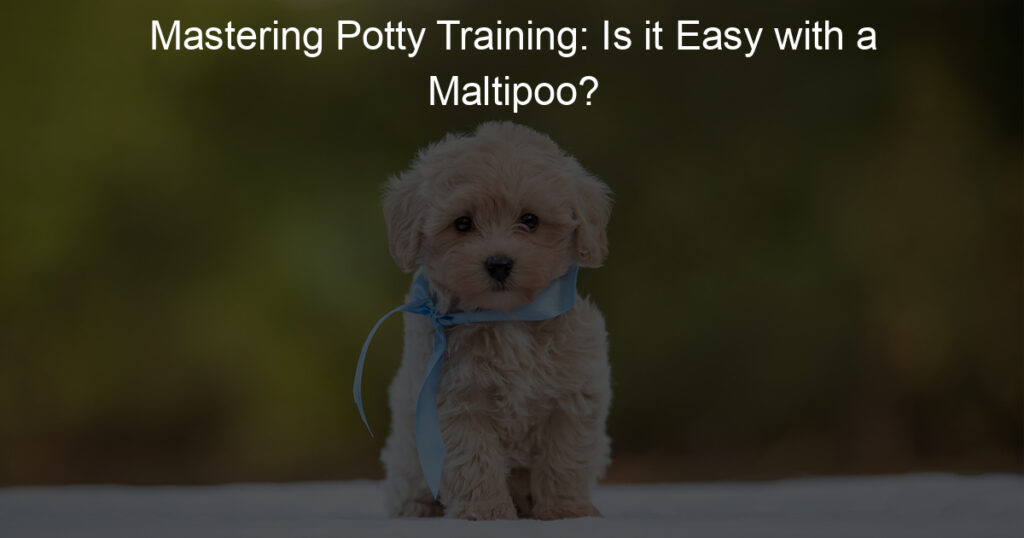
Introduction to Maltipoo Crate Training
Welcome to our comprehensive guide on Maltipoo crate training. In this section, we will delve into the basics of crate training, its importance, and clear up some common misconceptions.
- Understanding the Importance of Crate Training
- Common Misconceptions about Crate Training
Crate training is a crucial part of raising a Maltipoo puppy. It helps in establishing a routine, providing a safe space for your puppy, and aiding in housebreaking. It’s not just about confining your pet; it’s about creating a comfortable, secure environment that your Maltipoo can call its own. A well-crate trained Maltipoo is often happier, more confident, and better behaved.
Many people misunderstand the purpose of crate training, thinking it’s cruel or akin to punishment. This is far from the truth. When done correctly, crate training is a positive and effective method to manage your puppy’s behavior and teach them important life skills. It’s not about locking them away; it’s about providing a safe, cozy space where they can relax and feel secure. Remember, the crate should never be used as a form of punishment.
As we proceed, we will guide you through the process of crate training your Maltipoo, from preparation to overcoming common challenges. We’ll also share some inspiring success stories to motivate you along your crate training journey.
Preparing Your Maltipoo for Crate Training
Preparing your Maltipoo for crate training is an essential step in the training process. It’s not just about buying a crate and putting your puppy in it. It requires careful planning and preparation to ensure a smooth transition for your pet.
Assessing Crate Training Readiness
Before you start crate training your Maltipoo, it’s important to assess whether your pet is ready for it. This involves observing your pet’s behavior and preparing them mentally and physically for the training.
- Signs your Maltipoo is ready for crate training
- Your Maltipoo is comfortable being alone for short periods.
- Your pet shows no signs of anxiety or distress when confined in a small space.
- Your Maltipoo is able to control their bladder and bowel movements to some extent.
- How to prepare your Maltipoo for crate training
- Choose the right crate: The crate should be large enough for your Maltipoo to stand, turn around, and lie down comfortably. However, it should not be so large that your pet can use one corner as a bathroom.
- Make the crate comfortable: Add a soft blanket or a bed to the crate. You can also add a few toys to make the crate a more appealing place for your pet.
- Introduce the crate slowly: Don’t force your Maltipoo into the crate. Instead, introduce it slowly by placing treats or toys inside and allowing your pet to explore it at their own pace.
There are several signs that your Maltipoo is ready for crate training. These include:
If your Maltipoo shows these signs, it’s a good indication that they are ready for crate training.
Preparing your Maltipoo for crate training involves several steps:
Remember, crate training is not a one-size-fits-all process. It requires patience and understanding. Every Maltipoo is unique, and what works for one might not work for another. So, be prepared to adjust your approach based on your pet’s needs and responses.
Maltipoo Crate Training Guide
Training your Maltipoo to be comfortable in a crate is an important part of their development. It can provide a safe space for them and can be a useful tool for house training. Here are some tips to help you get started.
Crate Training Tips for Maltipoos
When it comes to crate training your Maltipoo, there are a few key steps to follow:
- Choosing the right crate: The crate should be large enough for your Maltipoo to stand, turn around, and lie down comfortably. However, it should not be so large that they can use one corner as a bathroom and the other as a sleeping area. A crate that is about 24 inches in length should be sufficient for most Maltipoos.
- Creating a comfortable environment: Make the crate a comfortable and inviting place for your Maltipoo. Add a soft blanket or a bed, and consider placing a few of their favorite toys inside. You can also cover the crate with a light blanket to create a den-like environment, which can help your Maltipoo feel more secure.
- Gradual introduction to the crate: Don’t rush the crate training process. Start by placing your Maltipoo near the crate and gradually encourage them to enter by placing treats or toys inside. Once they are comfortable entering the crate, you can start closing the door for short periods of time. Gradually increase the amount of time they spend in the crate, always ensuring they are comfortable and not showing signs of distress.
Remember, patience is key when it comes to crate training. It may take a few weeks for your Maltipoo to become fully comfortable in their crate, but with consistency and positive reinforcement, they will eventually see it as their safe space.
Maltipoo Crate Training Schedule
Creating a successful crate training schedule for your Maltipoo involves two key steps. First, you must establish a consistent schedule. Then, as your Maltipoo grows, you’ll need to adjust that schedule to suit their changing needs.
-
Creating a Consistent Schedule
Consistency is key when it comes to crate training your Maltipoo. Puppies thrive on routine, and a regular schedule can help them feel secure and comfortable. Begin by setting specific times for meals, play, and rest. This will help your Maltipoo understand what to expect each day.
For instance, you might feed your Maltipoo at 7 a.m., play with them at 8 a.m., and then put them in their crate for a nap at 9 a.m. Repeat this schedule throughout the day, adjusting as necessary for your own routine.
Remember, it’s important to keep your Maltipoo’s crate in a quiet, comfortable spot where they won’t be disturbed during their rest times. This will help them associate the crate with positive experiences.
-
Adjusting the Schedule as Your Maltipoo Grows
As your Maltipoo grows, their needs will change. They may require less sleep and more playtime. It’s important to adjust their crate training schedule to reflect these changes.
For example, as your Maltipoo becomes more active, you might need to increase their playtime and decrease their nap times. Always monitor your Maltipoo’s behavior to ensure they’re getting enough rest and stimulation.
Remember, crate training is a process, not an overnight solution. It requires patience, consistency, and understanding. But with time and effort, your Maltipoo will come to see their crate as a safe, comfortable space.
Crate Training Methods for Maltipoo
Training your Maltipoo to love their crate is a process that requires patience, consistency, and the right methods. Here, we will discuss three effective crate training methods that you can use with your Maltipoo.
- Positive Reinforcement Method
- Gradual Increase Method
- Mealtime Method
The positive reinforcement method is based on rewarding your Maltipoo for good behavior. This method encourages your dog to associate the crate with positive experiences. Start by placing a treat or a favorite toy inside the crate. When your Maltipoo goes inside to get it, praise them and give them another treat. Repeat this process, gradually increasing the time they spend in the crate. Remember, it’s essential to only reward your Maltipoo when they are calm and quiet in the crate.
The gradual increase method involves slowly increasing the amount of time your Maltipoo spends in their crate. Start with short periods, such as 5 minutes, and gradually increase the time as your Maltipoo becomes more comfortable. This method requires patience, but it’s a great way to ensure your Maltipoo doesn’t feel overwhelmed or anxious. Remember to always supervise your Maltipoo while they are in the crate to ensure they are safe and comfortable.
The mealtime method involves feeding your Maltipoo their meals inside the crate. This method helps your Maltipoo associate the crate with something they enjoy – mealtime. Start by placing their food bowl near the crate, then gradually move it inside over time. Eventually, your Maltipoo will be comfortable eating their meals inside the crate. This method can be particularly effective for Maltipoos that are food motivated.
Remember, every Maltipoo is unique and what works for one may not work for another. It’s important to be patient and consistent, and to try different methods until you find the one that works best for your Maltipoo.
Crate Confessions: Common Challenges in Maltipoo Crate Training
Training your Maltipoo to be comfortable in a crate can be a challenging task. One of the most common issues faced by Maltipoo owners is dealing with separation anxiety. Let’s delve into understanding this issue and how to overcome it.
Dealing with Separation Anxiety
Separation anxiety is a common problem in Maltipoos. It can make crate training difficult, but with patience and the right approach, it can be managed effectively.
- Signs of separation anxiety in Maltipoos
- How to help your Maltipoo overcome separation anxiety
Separation anxiety in Maltipoos can manifest in various ways. Some common signs include excessive barking or whining when left alone, destructive behavior like chewing on furniture or shoes, and attempts to escape from the crate. In some cases, your Maltipoo might also show signs of depression or lack of appetite.
Helping your Maltipoo overcome separation anxiety requires patience and consistency. Start by leaving your Maltipoo alone in the crate for short periods and gradually increase the duration. Provide toys and treats to make the crate a positive place. You can also try using calming aids like anxiety wraps or calming sprays. Remember, it’s important to avoid making a big fuss when you leave or return home to prevent reinforcing the anxiety.
Dealing with separation anxiety can be a challenging part of crate training. But with patience, understanding, and the right approach, you can help your Maltipoo feel safe and comfortable in their crate.
Addressing Nighttime Whining
One of the common challenges faced by Maltipoo owners is dealing with their pet’s nighttime whining. This section will help you understand why your Maltipoo whines at night and provide effective strategies to reduce this behavior.
- Understanding why your Maltipoo whines at night
- Effective strategies to reduce nighttime whining
- Establish a routine: Dogs thrive on routine. Make sure your Maltipoo has a consistent schedule for meals, playtime, and bedtime.
- Provide comfort: Ensure your Maltipoo’s crate is comfortable and inviting. Include their favorite toys and blankets.
- Address hunger: If your Maltipoo is hungry, consider adjusting their feeding schedule or providing a small snack before bedtime.
- Provide attention: Spend quality time with your Maltipoo before bedtime to fulfill their need for attention.
- Address separation anxiety: If your Maltipoo suffers from separation anxiety, consider consulting with a professional for guidance.
Whining is a form of communication for dogs. Your Maltipoo might be whining at night due to various reasons. It could be due to discomfort, hunger, need for attention, or even separation anxiety. It’s crucial to identify the cause to address it effectively.
| Reason | Signs |
|---|---|
| Discomfort | Restlessness, frequent changes in position |
| Hunger | Increased interest in food, begging |
| Need for attention | Whining when ignored, increased playfulness |
| Separation anxiety | Whining when left alone, destructive behavior |
Once you’ve identified the cause of your Maltipoo’s whining, you can implement strategies to reduce it. Here are some effective strategies:
Remember, patience is key when addressing your Maltipoo’s nighttime whining. With consistent effort and understanding, you can help your Maltipoo feel more comfortable and secure at night.
Case Studies: Successful Maltipoo Crate Training Stories
Let’s take a look at some real-life examples of Maltipoos who have successfully transitioned to crate training. These stories will provide inspiration and practical tips for your own training journey.
-
Case Study 1: Overcoming Separation Anxiety
Meet Bella, a lively Maltipoo who suffered from severe separation anxiety. Her owners noticed that she would become extremely distressed whenever they left her alone. Bella’s crate training journey began with short periods of time in the crate while her owners were still at home. Gradually, they increased the time Bella spent in the crate, always ensuring she had plenty of toys and treats to keep her occupied.
Over time, Bella began to see her crate as a safe space, and her separation anxiety significantly decreased. Her owners made sure to never use the crate as a punishment, reinforcing its role as a positive and secure environment. This case study shows that with patience and consistency, crate training can help alleviate separation anxiety in Maltipoos.
-
Case Study 2: Transitioning from a Playpen to a Crate
Next, let’s look at Max, a playful Maltipoo who was initially trained in a playpen. Max’s owners decided to transition him to a crate for better control and safety. They started by placing the crate inside the playpen, allowing Max to explore it at his own pace. They placed his favorite toys and blankets inside the crate to make it more inviting.
Over time, Max began to spend more time in the crate, eventually sleeping in it overnight. His owners then gradually moved the crate out of the playpen, ensuring Max was comfortable at each step of the process. This case study demonstrates that a gradual transition from a playpen to a crate can be a successful strategy for Maltipoo crate training.
These case studies highlight the importance of patience, consistency, and positive reinforcement in successful Maltipoo crate training. Remember, every dog is unique and what works for one may not work for another. It’s all about finding the right approach for your Maltipoo.
Key Takeaways: Maltipoo Puppy Crate Training
As we wrap up our comprehensive guide on Maltipoo crate training, let’s summarize the most important points that we’ve learned. These key takeaways will serve as your guiding principles as you embark on the journey of crate training your Maltipoo puppy.
- Patience and consistency are key
- Every Maltipoo is unique – adapt your approach accordingly
- Positive reinforcement leads to positive results
Training a Maltipoo puppy to get used to a crate is not an overnight process. It requires a lot of patience and consistency. Remember, your puppy is learning something new and it might take some time for them to get comfortable with the idea of staying in a crate. Stick to the routine and don’t rush the process. Consistency is key to successful crate training.
Just like humans, every Maltipoo has its own personality and temperament. What works for one might not work for another. Therefore, it’s important to observe your puppy’s behavior and adapt your training approach accordingly. For instance, some puppies might respond well to treats, while others might prefer praise or toys. Be flexible and willing to adjust your training methods to suit your Maltipoo’s individual needs.
Positive reinforcement is a powerful tool in dog training. By rewarding your Maltipoo for good behavior, you’re encouraging them to repeat that behavior. Whether it’s a treat, a toy, or a simple pat on the head, positive reinforcement can make crate training a positive and enjoyable experience for your Maltipoo. Remember, the goal is to make your puppy associate the crate with positive experiences, so they’ll be more willing to spend time in it.
In conclusion, crate training your Maltipoo puppy might seem like a daunting task at first, but with patience, consistency, and positive reinforcement, it can be a rewarding experience for both you and your furry friend. Remember, every Maltipoo is unique, so don’t be afraid to adapt your training approach to suit your puppy’s individual needs. Happy training!








